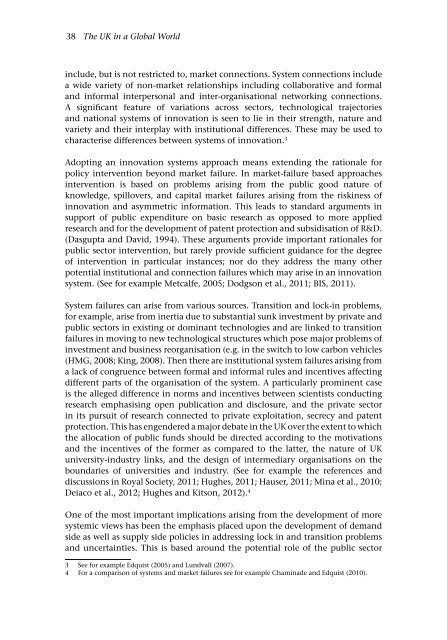The UK in a Global World - Vox
The UK in a Global World - Vox
The UK in a Global World - Vox
- No tags were found...
You also want an ePaper? Increase the reach of your titles
YUMPU automatically turns print PDFs into web optimized ePapers that Google loves.
38 <strong>The</strong> <strong>UK</strong> <strong>in</strong> a <strong>Global</strong> <strong>World</strong><strong>in</strong>clude, but is not restricted to, market connections. System connections <strong>in</strong>cludea wide variety of non-market relationships <strong>in</strong>clud<strong>in</strong>g collaborative and formaland <strong>in</strong>formal <strong>in</strong>terpersonal and <strong>in</strong>ter-organisational network<strong>in</strong>g connections.A significant feature of variations across sectors, technological trajectoriesand national systems of <strong>in</strong>novation is seen to lie <strong>in</strong> their strength, nature andvariety and their <strong>in</strong>terplay with <strong>in</strong>stitutional differences. <strong>The</strong>se may be used tocharacterise differences between systems of <strong>in</strong>novation. 3Adopt<strong>in</strong>g an <strong>in</strong>novation systems approach means extend<strong>in</strong>g the rationale forpolicy <strong>in</strong>tervention beyond market failure. In market-failure based approaches<strong>in</strong>tervention is based on problems aris<strong>in</strong>g from the public good nature ofknowledge, spillovers, and capital market failures aris<strong>in</strong>g from the risk<strong>in</strong>ess of<strong>in</strong>novation and asymmetric <strong>in</strong>formation. This leads to standard arguments <strong>in</strong>support of public expenditure on basic research as opposed to more appliedresearch and for the development of patent protection and subsidisation of R&D.(Dasgupta and David, 1994). <strong>The</strong>se arguments provide important rationales forpublic sector <strong>in</strong>tervention, but rarely provide sufficient guidance for the degreeof <strong>in</strong>tervention <strong>in</strong> particular <strong>in</strong>stances; nor do they address the many otherpotential <strong>in</strong>stitutional and connection failures which may arise <strong>in</strong> an <strong>in</strong>novationsystem. (See for example Metcalfe, 2005; Dodgson et al., 2011; BIS, 2011).System failures can arise from various sources. Transition and lock-<strong>in</strong> problems,for example, arise from <strong>in</strong>ertia due to substantial sunk <strong>in</strong>vestment by private andpublic sectors <strong>in</strong> exist<strong>in</strong>g or dom<strong>in</strong>ant technologies and are l<strong>in</strong>ked to transitionfailures <strong>in</strong> mov<strong>in</strong>g to new technological structures which pose major problems of<strong>in</strong>vestment and bus<strong>in</strong>ess reorganisation (e.g. <strong>in</strong> the switch to low carbon vehicles(HMG, 2008; K<strong>in</strong>g, 2008). <strong>The</strong>n there are <strong>in</strong>stitutional system failures aris<strong>in</strong>g froma lack of congruence between formal and <strong>in</strong>formal rules and <strong>in</strong>centives affect<strong>in</strong>gdifferent parts of the organisation of the system. A particularly prom<strong>in</strong>ent caseis the alleged difference <strong>in</strong> norms and <strong>in</strong>centives between scientists conduct<strong>in</strong>gresearch emphasis<strong>in</strong>g open publication and disclosure, and the private sector<strong>in</strong> its pursuit of research connected to private exploitation, secrecy and patentprotection. This has engendered a major debate <strong>in</strong> the <strong>UK</strong> over the extent to whichthe allocation of public funds should be directed accord<strong>in</strong>g to the motivationsand the <strong>in</strong>centives of the former as compared to the latter, the nature of <strong>UK</strong>university-<strong>in</strong>dustry l<strong>in</strong>ks, and the design of <strong>in</strong>termediary organisations on theboundaries of universities and <strong>in</strong>dustry. (See for example the references anddiscussions <strong>in</strong> Royal Society, 2011; Hughes, 2011; Hauser, 2011; M<strong>in</strong>a et al., 2010;Deiaco et al., 2012; Hughes and Kitson, 2012). 4One of the most important implications aris<strong>in</strong>g from the development of moresystemic views has been the emphasis placed upon the development of demandside as well as supply side policies <strong>in</strong> address<strong>in</strong>g lock <strong>in</strong> and transition problemsand uncerta<strong>in</strong>ties. This is based around the potential role of the public sector3 See for example Edquist (2005) and Lundvall (2007).4 For a comparison of systems and market failures see for example Cham<strong>in</strong>ade and Edquist (2010).














